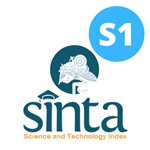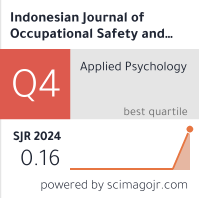What is the COVID-19 Risk Zone Colours Impact: Health Related-Quality of Life of Indonesian Healthcare Workers

Downloads
Introduction: In Indonesia, over 1000 healthcare workers have died due to COVID-19. Healthcare workers face increased workloads and negative perceptions, including discrimination and verbal or physical violence, which may impact their quality of life. Health-related quality of life encompasses both physical (PCS) and mental (MCS) health components. This study aims to analyze the health-related quality of life of healthcare workers who are obliged to service during the COVID-19 pandemic in Indonesia and occupational health and safety factors based on the workplace location risk zone. Methods: A cross-sectional online survey was conducted involving 149 healthcare workers from several areas of Indonesia as representatives from the red and orange risk zones. Health-related quality of life was measured using the SF-36 questionnaire. Differences in health-related quality of life scores were analyzed using Mann-Whitney test base on COVID-19 risk Zone and PPE availability. Results: Healthcare workers in the lower-risk (orange zone) exhibited better mental health scores (MCS 75±15.5) compared to those in the high-risk zone (red zone) (MCS 66.2±15.2). Additionally, those who received a complete set of PPE from their workplace had better health-related quality of life scores workplace (MCS 76.9±14.2, PCS 77±16) than those who lacked such provision (MCS 73±17.6, PCS 82±13.4). Furthermore, healthcare workers with access to PCR testing at their workplace tended to have higher quality of life scores than those who only had access to rapid testing. Conclusion: These findings highlight how the Health System addresses the pandemic, particularly regarding the health and safety of healthcare workers
Alami, H. et al. (2021) ‘How Can Health Systems Better Prepare for the Next Pandemic? Lessons Learned From the Management of COVID-19 in Quebec (Canada)’, Frontiers in Public Health, 9(June), p. 671833. doi: 10.3389/fpubh.2021.671833.
Alzamzami, A. A. et al. (2025) ‘Personal Protective Equipment Usage and Compliance among Healthcare Workers’, International Journal of Community Medicine and Public Health, 12(2), pp. 1–5. doi: https://dx.doi.org/10.18203/2394-6040.ijcmph20250043.
Andersen, J. R. et al. (2022) ‘Correlated physical and mental health composite scores for the RAND-36 and RAND-12 health surveys: can we keep them simple?’, Health and Quality of Life Outcomes. BioMed Central, 20(1), pp. 1–8. doi: 10.1186/s12955-022-01992-0.
Black, J. R. M. et al. (2020) ‘COVID-19: the case for health-care worker screening to prevent hospital transmission’, The Lancet, 395(10234), pp. 1418–1420. doi: 10.1016/S0140-6736(20)30917-X.
Center for Disease Control and Prevention (2021) Using antibody tests, cdc.gov. Available at: https://www.cdc.gov/coronavirus/2019-ncov/lab/resources/antibody-tests.html (Accessed: 2 October 2021).
COVID-19 Task Force (2020a) COVID-19 Risk Zone Mapping, covid19.go.id. Available at: https://covid19.go.id/peta-risiko (Accessed: 22 December 2021).
COVID-19 Task Force (2020b) Personal Protective Equipment (PPE) standards for handling COVID-19 in Indonesia, Standar Alat Pelindung Diri (APD) Untuk Penanganan Covid-19 di Indonesia.
Dzinamarira, T. et al. (2022) ‘Risk Factors for COVID-19 Infection Among Healthcare Workers. A First Report From a Living Systematic Review and meta-Analysis’, Safety and Health at Work, pp. 263–268. doi: 10.1016/j.shaw.2022.04.001.
Elgibaly, O. et al. (2021) ‘Knowledge, perception, and confidence of healthcare workers about COVID-19 preventive measures during the first wave of the pandemic: A cross-sectional study from Egypt’, Germs, 11(2), pp. 179–188. doi: 10.18683/germs.2021.1255.
Government of Ontario (2024) COVID ‑ 19 testing and treatment. Available at: https://www.ontario.ca/page/covid-19-testing-and-treatment (Accessed: 21 July 2024).
Hadning, I. and Ainii, N. Q. (2020) ‘An Analysis of Health Workers’ Quality of Life in Indonesia During COVID-19 Pandemic’, Proceedings of the 4th International Conference on Sustainable Innovation 2020–Health Science and Nursing (ICoSIHSN 2020), 33(ICoSIHSN 2020), pp. 425–430. doi: 10.2991/ahsr.k.210115.085.
Jang, Y. et al. (2021) ‘Burnout and peritraumatic distress of healthcare workers in the COVID-19 pandemic’, BMC Public Health, 21(1), pp. 1–9. doi: 10.1186/s12889-021-11978-0.
Kimura, M. et al. (2022) ‘Health-Related Quality of Life Evaluation Using the Short Form-36 in Patients With Human T-Lymphotropic Virus Type 1-Associated Myelopathy’, Frontiers in Medicine, 9(April), pp. 1–11. doi: 10.3389/fmed.2022.879379.
Kotijah, S. and Wahyuni, L. (2022) ‘Mental Health and Quality of Life for Health Workers During the COVID-19 Pandemic: A Systematic Review’, Psychiatry Nursing Journal (Jurnal Keperawatan Jiwa), 4(1), pp. 11–28. doi: 10.20473/pnj.v4i1.33569.
Lapor COVID-19 (2021) Mortality prevalence of healthcare workers against COVID-19, nakes.laporcovid19.org. Available at: https://nakes.laporcovid19.org/statistik (Accessed: 29 July 2021).
Mitigation Team of Indonesian Physicians Association (2020) Guidelines standards for Doctor Protection in the Era of COVID-19, Indonesian Physicians Association. Edited by V. H. Putri. Jakarta: Indonesian Physicians Association.
Mutambudzi, M. et al. (2021) ‘Occupation and risk of severe COVID-19: Prospective cohort study of 120 075 UK Biobank participants’, Occupational and Environmental Medicine, 78(5), pp. 307–314. doi: 10.1136/oemed-2020-106731.
Okediran, J. O. et al. (2020) ‘The experiences of healthcare workers during the covid-19 crisis in lagos, nigeria: A qualitative study’, Germs, 10(4), pp. 356–366. doi: 10.18683/germs.2020.1228.
Prajogo, D. et al. (2021) Occupational Health and Safety (OHS): Protecting the Indonesian Healthcare Workforce during the COVID-19 Pandemic.
Presiden RI (2023) ‘Undang-Undang Republik Indonesia Nomor 17 Tahun 2023 Tentang Kesehatan’, Undang-Undang, (187315), pp. 1–300.
Putri, B. D. et al. (2021) ‘The Indonesian Version of SF-36 Questionnaire: Validity and Reliability Testing in Indonesian Healthcare Workers Who Handle Infectious Diseases’, Indian Journal of Forensic Medicine & Toxicology, 15(2), pp. 2114–2121. doi: 10.37506/ijfmt.v15i2.14677.
RAND (2020) 36-Item Short Form Survey (SF-36) Scoring Instructions, rand.org. Available at: https://www.rand.org/health-care/surveys_tools/mos/36-item-short-form/scoring.html (Accessed: 22 December 2020).
Rivett, L. et al. (2020) ‘Screening of healthcare workers for SARS-CoV-2 highlights the role of asymptomatic carriage in COVID-19 transmission’, eLife, 9, pp. 1–20. doi: 10.7554/eLife.58728.
Schramme, T. (2023) ‘Health as Complete Well-Being: The WHO Definition and Beyond’, Public Health Ethics, 16(3), pp. 210–218. doi: 10.1093/phe/phad017.
Shrivastava, S. R. and Shrivastava, P. S. (2020) ‘Standardized risk assessment and management of exposure amongst healthcare workers to coronavirus disease 2019’, Germs, 10(2), pp. 126–128. doi: 10.18683/germs.2020.1196.
Siregar, D. et al. (2022) ‘Quality of Life among Indonesian during the COVID-19 Pandemic’, Macedonian Journal of Medical Sciences, 10(E), pp. 1788–1792. doi: 10.3889/oamjms.2022.10607.
Syamlan, A. T. et al. (2022) ‘Mental health and health-related quality of life among healthcare workers in Indonesia during the COVID-19 pandemic: A cross-sectional study’, BMJ Open, 12(4), pp. 1–10. doi: 10.1136/bmjopen-2021-057963.
Tewani, K. et al. (2022) ‘Anxiety and burnout among healthcare workers during the COVID-19 circuit breaker in a Women’s and Children’s Hospital in Singapore’, Germs, 12(1), pp. 137–141. doi: 10.18683/germs.2022.1317.
Ulinici, M. et al. (2021) ‘Screening, diagnostic and prognostic tests for COVID-19: A comprehensive review’, Life, 11(6), pp. 1–14. doi: 10.3390/life11060561.
UNICEF (2021) Three reasons why personal protective equipment (PPE) supply remains critical, unicef.org.
Williams, B. A. et al. (2023) ‘Outlook of pandemic preparedness in a post-COVID-19 world’, npj Vaccines, 8(1). doi: 10.1038/s41541-023-00773-0.
World Health Organization (2020) Protecting health workers from COVID-19, World Health Organization. Available at: https://www.who.int/westernpacific/news-room/feature-stories/item/protecting-health-workers-from-covid-19 (Accessed: 15 July 2021).
World Health Organization (2021) Health and Care Worker Deaths during COVID-19, World Health Organization. Available at: https://www.who.int/news/item/20-10-2021-health-and-care-worker-deaths-during-covid-19 (Accessed: 19 July 2025).
Worldometers (2021) COVID-19 Corona Virus Pandemic, worldometers.info. Available at: https://www.worldometers.info/coronavirus/ (Accessed: 29 July 2021).

This work is licensed under a Creative Commons Attribution-NonCommercial-ShareAlike 4.0 International License.

In order to be accepted and published by The Indonesian Journal of Occupational Safety and Health, Author(s) who submit an article should complete all the review process. The copyright of received articles assigned to the The Indonesian Journal of Occupational Safety and Health and Department of Safety and Health, Universitas Airlangga as publishers of the journal. The intended copyright includes the rights to publish articles in various forms (including reprints).
The Editorial Team of The Indonesian Journal Of Occupational Safety and Health and Department of Safety and Health strive to ensure that no errors occur in the articles that have been published, both data errors and statements in the article.
Users of this website will be licensed to use materials from this website following the Creative Commons Attribution-NonCommercial-ShareAlike 4.0 International License. No fees charged. Please use the materials accordingly.
------------------------------------------------------------------------------------------------------------------------------------------------------------------------------------------
Attribution ” You must give appropriate credit, provide a link to the license, and indicate if changes were made. You may do so in any reasonable manner, but not in any way that suggests the licensor endorses you or your use.
NonCommercial ” You may not use the material for commercial purposes.
ShareAlike ” If you remix, transform, or build upon the material, you must distribute your contributions under the same license as the original.







 How to Submit Articles in OJS
How to Submit Articles in OJS

























